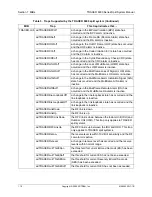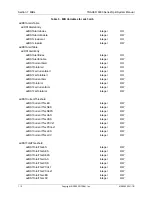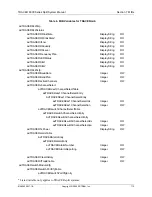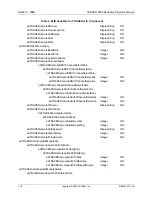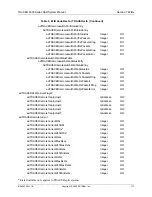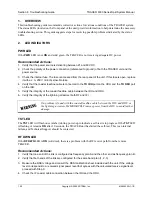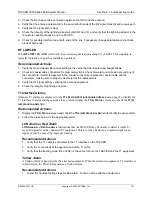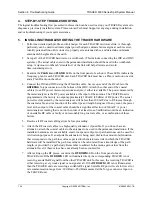
TRACER 6000 Series Split System Manual
Section 8 Troubleshooting Guide
612806320L1-1B
Copyright © 2005 ADTRAN, Inc.
123
Recommended Actions:
1.
Verify the TRACER unit and the attached equipment are configured for the same line coding (
HDB3
or
AMI
).
2. Verify the cable connections for the E1 interface are solid.
CRC
CRC errors indicate that the receiver is unable to synchronize to the CRC-4 frame pattern of the received
E1 signal.
Recommended Actions:
1.
Verify the TRACER unit and the attached equipment are configured for the same signaling
(
M
ULTIFRAMED
,
U
NFRAMED
, or
F
RAMED
).
2. Verify the cable connections for the E1 interface are solid.
LAN LEDs
If the
LAN
LED is
OFF
, the TRACER is not able to detect an active Ethernet link on the particular
10/100BaseT/TX interface.
Recommended Actions:
1.
Check all Ethernet cable connections to verify they are properly plugged in (making sure the tab on the
connector snaps into place).
2.
Connect the 10/100BaseT/TX interface to a “known good” Ethernet port to verify the TRACER port is
functioning properly.
3.
Try another Ethernet cable.
3.
RF ERRORS
RF errors can range from a nonviable microwave path to loose RF connectors.
Nonviable path conditions could be caused by physical obstructions such as buildings, mountainous terrain,
trees, etc., as well as other physical limitations such as excessive path distances and in-band RF interference.
These types of errors are remedied by performing a detailed line-of-site microwave path study to determine
whether a microwave link is feasible for the terrain and environment under consideration.
If after performing a microwave path study the system is still not operational, ensure that the antennas are
properly aligned. Note that alignment must be achieved in both elevation and azimuth for optimal link
performance. The TRACER can be used to aid in antenna alignment by looking at the
R
X
P
OWER
“fuel gauge”
on the
S
YSTEM
S
TATUS
or
S
YSTEM
O
PTION
menu pages or by measuring the DC voltage (relative to ground) at
the IDU or ODU RSSI test jack. Optimal antenna alignment is achieved by peaking the RSSI voltage and the
R
X
P
OWER
“fuel gauge” on the TRACER terminal display. Consult the ADTRAN TRACER Data Sheet
included with the unit to verify that the actual receive signal level agrees with the calculated receive signal.
RSSI
test points, located on the front panel of the IDU and beneath a weatherproof cover on the bottom of the
ODU, provide a DC voltage level (relative to the
GND
test points) that corresponds to the amount of signal
being received from the far end’s transmitter. The voltages at these test points can vary from approximately 0
to 5 VDC. An RSSI calibration sheet is shipped with the system to provide the installer a cross-reference
between actual received signal level (in dBm) and RSSI voltage. This sheet is useful for verifying link budget
calculations and ensuring proper equipment installation.
Содержание TRACER 6000 SERIES
Страница 10: ...Table of Contents TRACER 6000 Series Split System Manual 10 Copyright 2005 ADTRAN Inc 612806320L1 1B...
Страница 14: ...Section 1 System Description TRACER 6000 Series Split System Manual 14 Copyright 2005 ADTRAN Inc 612806320L1 1B...
Страница 88: ...Section 5 User Interface Guide TRACER 6000 Series Split System Manual 88 612806320L1 1B...
Страница 90: ...Section 6 Detail Level Procedures TRACER 6000 Series Split System Manual 90 612806320L1 1B...
Страница 98: ...Section 5 DLP 3 TRACER 6000 Series Split System Manual 98 Copyright 2005 ADTRAN Inc 612806320L1 1B...


